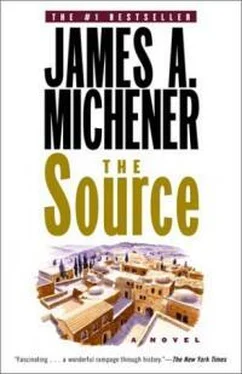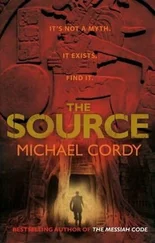Jesus Christ was born, so far as we know, in the summer of 6 B.C.E.., that being sometime before the death of King Herod the Great. Jesus lived his early life in Nazareth, only sixteen miles south of Makor, and conducted his principal ministry, which covered a span of one year and nine months, along the shores of the Sea of Galilee, only eighteen miles to the east. He never came to Makor and about April 7, 30 C.E., was crucified by order of Pontius Pilate, the Roman who then served as Procurator of Judaea.
It may be surprising, therefore, to know that it was not until the year 59 C.E. that the name of Jesus Christ, the good neighbor of Makor, was first mentioned in that little town; but upon reflection this is not so remarkable. In the turbulent years of Christ’s mission on earth there were many young Jews wandering up and down the Galilee. Some, like General Josephus, tried merely to rally their people to resistance against Rome, and their motives were military. Others sought to convince the Jews that an independent government was needed, and their intentions were political. Some wandered from one community to the next, preaching stern systems for the redemption or reconstruction of Judaism, and their dreams were religious. And some went from town to town prophesying the coming of one messiah or another. A few of these latter had reached Makor, on the edge of the Jewish lands, but the rabbi Jesus was not among them.
Nor was it unusual that the town had not heard about His crucifixion on a hill outside Jerusalem, for that event was in no way unusual; one Jewish king had crucified eight hundred of his subjects on one afternoon while getting drunk with his concubines on a public platform in the middle of Jerusalem, to which his guests had been invited to enjoy the spectacle. In recent years King Herod had crucified a multitude of Jews, while lesser Roman officials had also used this traditional punishment with harsh frequency. Furthermore, the major contacts of a frontier town like Makor were never with Jerusalem or Nazareth, nor even with the settlements along the Sea of Galilee; they had to be with Ptolemais, that alien port so near at hand yet almost always in the grip of strangers who followed exotic religions. Thus, when Makor was Egyptian, Akka had belonged to the Sea People. When Makor was part of David’s kingdom, Accho was Phoenician. When Makor was ruled by Herod, Ptolemais was held by Cleopatra. And in the time of Christ, when Makor was governed by the procurators of Judaea, Ptolemais belonged to whatever Roman puppets controlled Syria. Makor had to worry about Ptolemais, not Jerusalem.
Yet it was because of Ptolemais, that ancient, ancient seaport to which triremes from Athens and hippos from Tyre had always sailed, that Makor finally heard of Jesus Christ. In the spring of 59 C.E., when the crucified prophet had been all but forgotten even in areas which had known Him well, a Roman corn ship came down from Puteoli and Piraeus to drop anchor in the fish-hook harbor of Tyre, where the captain gave deck space to a frail, baldheaded man in his sixties seeking passage to Caesarea; and next day, when the vessel had wandered down the coast a short distance to the snug harbor of Ptolemais, the traveler took advantage of the unexpected layover to go ashore and harangue any Jews who might be lounging along the waterfront. And among his chance audience at the port that day had been that same Yigal of Makor who had some years before offered his life in this city to halt the advance of General Petronius and the Roman statues, and it was by this accident that Yigal became the first resident of Makor to hear the message of Jesus Christ.
In heavily accented Hebrew the speaker had said with some pride that he was Paul of Tarsus, “a city of more than half a million lying to the north,” and he explained to the Jews of Ptolemais that although he was a free Roman citizen he was also a Jew, a Pharisee of strict education, but that a greater Jew than he had taught in Galilee and had shown men how the old preaching must give way to the new, how the law must be fulfilled outside the synagogue, and how the salvation of the human soul could be attained by following in His steps.
Paul spoke with clarity, relying upon reason to persuade his listeners. As he stood in the open air, a small man with bandy legs and a great hooked nose that sprang from the point where his thick eyebrows met, he showed signs of nervous exhaustion, as if time were slipping through his fingers; he had much to relate that day in Ptolemais, and the dull in-difference of Jews like Yigal, who stood with his hands folded behind his back, trying to calculate what the visitor was trying to say, seemed to infuriate the baldheaded stranger, and he spoke with terrible persuasiveness. He explained to the Jews that they had a chance now, on this sunny day in Ptolemais, to receive into their hearts the man who had been crucified to save the world.
“Was not this Jesus a rabbi?” a Phoenician Jew asked.
“His disciples called Him such,” Paul replied.
“Our rab is good enough for us,” the indifferent man said, and Paul did not bother to argue with him. Instead, he turned his back upon the Jews, and looking toward the sea as if he were addressing the world, explained in tempestuous Greek phrases the tenets of the new religion: “Why is there evil in the world? Because we are born in sin. How can we be saved? Because Jesus Christ, through His crucifixion, takes our sin upon His shoulders.” For some moments he addressed his impassioned oratory to Yigal, who felt a tingle down his spine as this Jewish convert to Jesus spoke of the new world of Christ in which the law of Moses was fulfilled. But Yigal mastered his excitement. He could not be attracted permanently to any religion that had abandoned Judaism, heading for new directions which he could not foresee, so he left the meeting in Ptolemais and returned to Makor. For some few days the words of Paul of Tarsus disturbed him, and for a while he thought of discussing them with Rab Naaman, but he did not do so; and as we have seen, eight years later in 67 C.E. he was caught up in struggles against the might of Rome and was himself crucified not far from Nazareth—at about the time that Paul was being beheaded for somewhat similar reasons in Rome.
But if Makor was slow to acknowledge the reality of Jesus Christ, the time came when His presence reached the little town with persuasive grace. In the year 313 the Roman emperor Constantine had seen on the eve of a vital battle near Rome a fiery cross bearing the promise “In hoc signo vinces,” and when that prophecy proved true, he had by decree ordained Christianity to be the religion of the whole Roman empire, one of the most fateful single acts ever performed by one man. And in 325 he encouraged his mother, an extraordinary woman, to go on a pilgrimage to the Holy Land to see if she could identify the places where Jesus had lived three centuries earlier.
Queen Helena had known an uneven life: a free-and-easy waitress in a Bulgarian inn, she had married a passing soldier, and when he was later offered the Caesarship it was on condition that he abandon his wife and find another more suitable, and to this he agreed. In her loneliness Queen Helena had discovered the consolations of Christianity and had encouraged her pagan friends to do the same; and when her son assumed the purple she moved from obscurity to prominence, so that her pilgrimage to the Holy Land was an event of significance. While sleeping in Jerusalem she had a vision much like her son’s: she saw the precise location not only of the cross on which Christ died but also of the sepulcher in which the body of Jesus had lain for two days. In subsequent visions she identified most of the other sacred spots, and over each one her son caused a basilica to be erected, which would serve as the focus of pilgrimages for as long as men loved Christ.
Читать дальше








![Джеймс Купер - Пионеры, или У истоков Саскуиханны [The Pioneers, or The sources of the Susquehannah]](/books/395797/dzhejms-kuper-pionery-ili-u-istokov-saskuihanny-t-thumb.webp)

